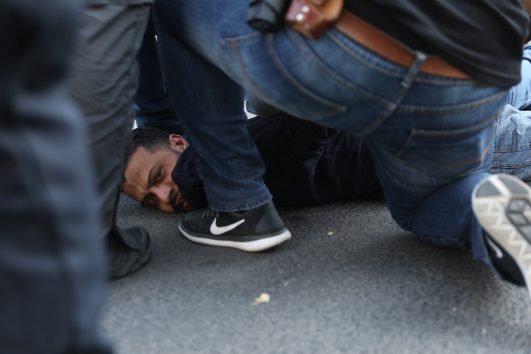Both the U.S. and Israeli governments are run by racist demagogues who simultaneously deny an occupation exists while doing all they can to perpetuate it.

Jerusalem Mayor Nir Barkat believes that East Jerusalem Palestinians are “satisfied” with the move of the U.S. Embassy to their city. Speaking to Israeli news website Ynet on Sunday, as the Israeli side of Jerusalem was preparing for a mass celebration in honor of the transfer, Barkat suggested that deep down, Palestinians understood that having the embassy on their doorstep would improve their quality of life.
Barkat’s reasoning is, on the one hand, simply a variation on the racist idea that colonialism betters the lives of the natives. It’s also in keeping with his previous reflections on demographic tensions in Jerusalem: he’s both declined to attend the city’s annual Pride parade out of deference to his ultra-Orthodox constituents (a year after a haredi man murdered a parade attendee and wounded five others), and announced that collective punishment of Palestinians is the key to coexistence.
Yet claiming that Palestinians might welcome the embassy transfer, which effectively marks the U.S.’s rubber-stamping of Israel’s half-century occupation in East Jerusalem, is also a consummate example of hasbara logic. Nearly three-quarters of Palestinian Jerusalemites — who make up nearly 40 percent of the city’s population — live below the poverty line, compared to just under 30 percent of Jewish Jerusalemites. Israeli authorities demolished over 170 Palestinian homes and other structures in the city last year. In 2013, the last year such data was published, the Jerusalem municipality allotted only 10 percent of its budget to Palestinian neighborhoods. Forty percent of Palestinian households in East Jerusalem are not properly connected to the water grid.
This state of affairs is in large part due to the Israeli government’s chronic underinvestment in the Palestinian parts of the city (or, rather, underinvestment in infrastructure that would benefit Palestinians: earlier this month, for example, the state approved NIS 47 million over two years for archaeological excavations in the Palestinian neighborhood of Silwan — projects being run by a private, right-wing settler organization).
Nonetheless, Barkat is prepared to announce that he has looked into the hearts of Palestinians, and seen that they are pleased with a move that gives legitimacy to the discrimination they encounter on their own land, that will erase them further from the face of their own city, and that will bring even greater scrutiny of their day-to-day lives by the security services. It’s a lie sprung from the same ideological well as the concept that Jerusalem — as territorially, legally, and demographically divided as it is — is somehow a “unified” city. Such is the inverse reasoning of Israeli state propaganda: what’s shattered is whole, what’s repressive is liberatory, war is peace, etc.
Jerusalem fiddles while Gaza burns
Barkat’s comments, and the widespread mentality they reflect, give us one lens onto the alternate reality created by official Israeli talking points. But the timing of the U.S. embassy move, and the effect of the pageantry surrounding it, lead us to an even more fundamental truth about how the Israeli government — and its overseas sponsors, not least, these days, the U.S. government — distracts and dissembles when it comes to the rights of Palestinians living under its control.
The embassy move was scheduled for May 14th, in order to mark the 70th anniversary (according to the Gregorian calendar) of the establishment of the State of Israel. Palestinians mark Nakba Day on May 15th each year. And this year, owing to the differences in the lunar Hebrew calendar, Jerusalem Day fell on May 13th. On one side of the U.S. embassy opening, then, was the day Israelis celebrate the “reunification” of Jerusalem. On the other side, the day Palestinians mourn the ethnic cleansing and theft of their land that accompanied Israel’s establishment. In other words, the embassy move was symbolically sandwiched between the occupation and the Nakba — and is evidence of not only the short- and long-term ramifications of both, but also the connection between them.

Nakba Day and Jerusalem Day represent different stages in the same process: both mark events that led to mass expulsions of Palestinians, and whose legacies have allowed for their continued displacement, dispossession, jailing and killing at the hands of the state. One is marking its 70th anniversary this year, the other its 51st anniversary. One is observed from the perspective of the colonized, who want to return home; the other from the perspective of the colonizer, who deny that home exists. But those differences aside, the two days belong on the same spectrum.
Moreover, both occasions are subject to the same rhetorical tactics by the Israeli government and its proxies, whether supportive U.S. officials or college kids participating in hasbara initiatives. The legitimization of Jerusalem Day and the delegitimization of Nakba Day both rely on a narrative that denies the existence of a Palestinian people, which is subsequently held to justify scraping their presence from the surface of the land and disappearing their society from the pages of history.
This narrative creates a feedback loop between Israeli state violence and the talking points used to gird it: the story justifies the violence, and the violence demands the story. Both assume that it is possible, and indeed reasonable, to use force and falsehoods to uproot an entire population — and then to pour endless resources into bringing the rest of the world in on this fiction, as if a people can be magicked away by sheer force of imagination. If you will it, it is no dream.
Given these dynamics, it is not surprising that the authoritarians, Islamophobes, and Christian Zionists among the Trump administration and its backers — all faithful devotees of the post-truth political model — saw fit to engineer the transfer of the U.S. embassy to Jerusalem, giving an American imprimatur not only to Israel’s occupation, but also to the increasingly brazen propaganda that denies there is an occupation at all.
It is also, sadly, not surprising that the cheerleaders of the embassy move had no qualms about talking up a “moment of celebration” at the same time as dozens of Palestinians taking part in protests along the Gaza border were being shot dead by Israeli snipers. Those protests marked both resistance to the U.S. embassy transfer and the culmination of seven weeks of demonstrations commemorating the 70th anniversary of the Nakba, which have been met with inconceivable violence by the Israeli army.
It is abundantly clear that both occasions exist on a continuum, even as the Israeli government does all it can to separate, isolate, and undermine the meaning of each. The deadly consequences of this operation — conducted without the slightest sense of shame, self-awareness or historical sensitivity — were made horrifyingly clear on Monday.
That Israeli and American officials took part in the Jerusalem embassy festivities at all, and, moreover, as a massacre was occurring on the Gaza border, demonstrates equal parts contempt for Palestinian lives and cluelessness about how their actions are perceived by much of the watching world. But both the U.S. and Israeli governments are, these days, in the hands of racist demagogues for whom the U.S. embassy move was the perfect way to mark the Nakba.

